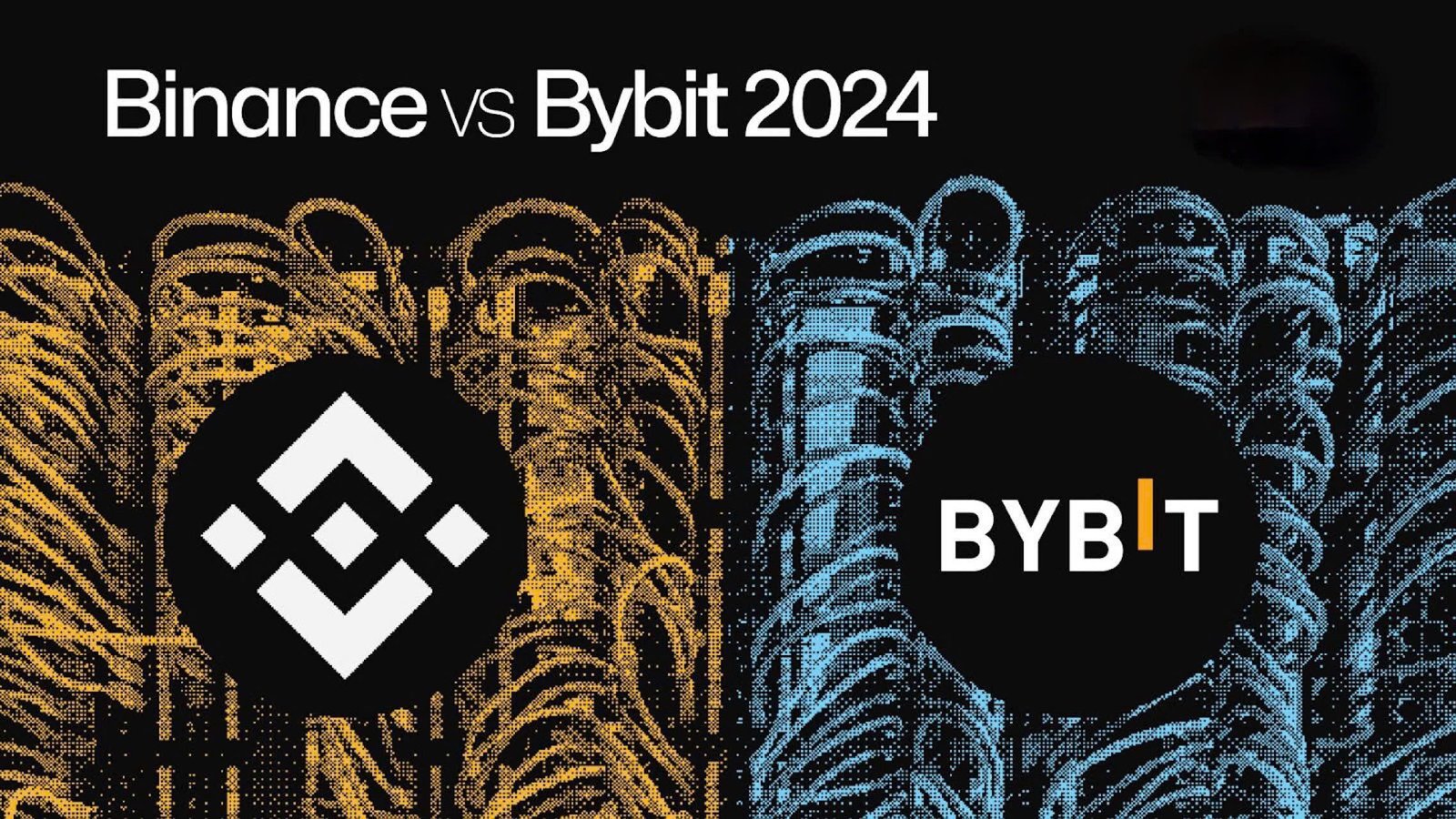Choosing between Bybit and Binance can be a daunting task, especially for those new to the world of cryptocurrency trading. Both platforms have carved a niche for themselves in the competitive landscape of crypto exchanges, offering distinct features and benefits to cater to different trading styles.
Bybit has established a reputation for its focus on derivatives trading. It provides advanced tools and features tailored to the needs of professional traders. Its copy trading functionality is particularly noteworthy, allowing users to replicate the strategies of successful traders.
Bybit vs Binance: A Deep Dive into Fees, Features, and Security for Crypto Traders

On the other hand, Binance is renowned for its high trading volume. It’s a popular choice for traders looking to execute large-scale trades. The platform’s wide range of services and deep liquidity make it a go-to destination for many.
Key Differences and Considerations:
- Derivatives Trading: If you’re primarily interested in derivatives trading, Bybit’s advanced tools and features make it a compelling choice. Binance also offers derivatives trading, but Bybit’s focus on this area gives it a slight edge.
- Cryptocurrency Offerings: Bybit boasts a more extensive selection of cryptocurrencies, with over 1,200 coins available. Binance, while offering a respectable number of coins, primarily focuses on high-cap and popular assets.
- Trading Volume: Binance’s higher trading volume can be advantageous for traders seeking deep liquidity and the ability to execute large orders without significantly impacting the market price.
- Fees: Both platforms charge similar spot trading fees. However, Binance has a slight advantage in terms of futures taker fees, which are lower than Bybit’s.
- Copy Trading: Bybit’s copy trading platform is more robust and offers a wider range of options compared to Binance.
- Security: Both Binance and Bybit prioritize security and have implemented robust measures to protect user funds. Binance’s SAFU fund, which is worth over $1 billion, is a notable security feature.
The best choice between Bybit and Binance depends on your individual trading preferences and needs. If you’re primarily interested in derivatives trading, advanced tools, and a wider selection of cryptocurrencies, Bybit might be the better option. However, if you prioritize high trading volume, deep liquidity, and a more extensive range of services, Binance could be a more suitable choice.
It’s recommended to thoroughly research both platforms and consider factors such as your trading style, risk tolerance, and the specific cryptocurrencies you want to trade before making a decision.
What is Bybit?
Bybit is a leading cryptocurrency derivatives trading platform that has rapidly gained traction since its inception in 2018. It offers a diverse range of trading services, catering to both novice and experienced traders. With over 40 million users worldwide, Bybit has established itself as a prominent player in the cryptocurrency market.
One of Bybit’s key selling points is its high-leverage trading. Traders can borrow up to 100x their initial investment, enabling them to potentially amplify their profits. However, it’s important to note that this also increases the risk of significant losses.
Beyond derivatives trading, Bybit provides spot trading for those who prefer to buy and sell cryptocurrencies directly. The platform supports a vast array of assets, including popular cryptocurrencies like Bitcoin and Ethereum. Additionally, Bybit’s “Bybit Earn” feature allows users to generate passive income through interest on their cryptocurrency holdings.
Security is a top priority for Bybit. The platform employs robust measures such as two-factor authentication and cold storage to protect user funds. However, it’s essential to remember that no trading platform is entirely risk-free.
Key Advantages of Bybit:
- High-leverage trading: Up to 100x leverage on popular assets.
- Wide range of supported cryptocurrencies: Over 1200 coins and tokens.
- Competitive trading fees: Discounts for high-volume traders.
- Web3 features: Wallet and in-built DeFi swap.
- Options trading: For experienced traders.
Key Limitations of Bybit:
- Geographic restrictions: Not available for U.S. citizens.
- Limited fiat deposit and withdrawal methods: Fewer options compared to some other exchanges.
- Low liquidity for newly listed assets: May impact trading opportunities.
Bybit offers a compelling combination of high-leverage trading, a vast selection of cryptocurrencies, and advanced security features. However, potential users should carefully consider the platform’s limitations, particularly geographic restrictions and the risks associated with high-leverage trading.
What is Binance?
Binance has emerged as a behemoth in the cryptocurrency exchange landscape, boasting over 225 million registered users. Its immense popularity stems from a powerful combination of high trading volume, deep liquidity, and a diverse suite of features.
Unmatched Liquidity and Trading Volume: Binance reigns supreme when it comes to trading volume, offering unrivaled liquidity for crypto assets. This makes it a haven for day traders who capitalize on short-term price fluctuations with minimal slippage (difference between expected and executed price).
A Feast of Trading Options: Binance caters to both novice and seasoned traders with a comprehensive array of services beyond just spot trading. Its offerings include:
- Futures Trading: Trade on leveraged contracts to speculate on future price movements.
- Margin Trading: Borrow funds to amplify your buying power and potential profits (but also potential losses).
- Launchpad: Participate in the initial offerings of promising new crypto projects.
- NFT Marketplace: Buy, sell, and trade non-fungible tokens.
- Staking: Earn passive income by holding specific cryptocurrencies.
Binance Chain (formerly Binance Smart Chain): This native blockchain facilitates faster and cheaper transactions compared to the Ethereum network, further enhancing the platform’s efficiency.
Global Reach and Fiat Support: Unlike Bybit, Binance boasts global accessibility, supporting over 40 fiat currencies and offering services in over 100 countries. Additionally, peer-to-peer trading options cater to users who prefer direct interactions with other traders.
Binance Earn: This lucrative feature allows users to generate passive income by staking their crypto holdings. While some assets can offer APY (Annual Percentage Yield) exceeding 100%, it’s crucial to understand the associated risks.
Security and Compliance: Despite facing past legal and regulatory hurdles, Binance has demonstrated a strong commitment to compliance. The platform prioritizes user safety with robust security measures and a dedicated $1 billion SAFU (Secure Asset Fund for Users) to protect against security breaches.
Expanding into Web3: Binance recognizes the potential of Web3 technologies and has actively embraced them. The platform offers tools like self-custodial wallets, empowering users with greater control over their digital assets.
Binance Cons:
- Limited Altcoin Selection: While offering a substantial variety of cryptocurrencies, Binance focuses primarily on popular and high-cap assets. Users seeking access to a broader spectrum of altcoins might need to look elsewhere.
- Separate U.S. Platform: U.S. residents face limitations with a separate platform, Binance.us, that has a reduced feature set compared to the global platform.
Overall, Binance represents a powerful and versatile crypto exchange. Its high trading volume, diverse features, and global reach make it an attractive option for a wide range of traders. However, users should be aware of the limited altcoin selection and potential regulatory challenges in certain jurisdictions.
Bybit vs. Binance: A Deep Dive into Fees
Spot Trading Fees:
Both Bybit and Binance employ a maker-taker fee structure for spot trading. While the base fees are similar, the actual costs can vary significantly based on VIP status and trading volume.
- Bybit: Regular users face a 0.1% fee for both makers and takers. However, VIP levels offer substantial discounts.
- Binance: The base fee is also 0.1%, but Binance offers a 25% discount when using BNB to pay. Additionally, VIP tiers provide further reductions.
Futures Trading Fees:
Futures trading fees are generally lower on both platforms.
- Bybit: Base rates are 0.02% for makers and 0.055% for takers, with VIP discounts applicable. A settlement fee of 0.05% is charged upon contract expiration.
- Binance: Base rates are 0.02% for makers and 0.05% for takers, with VIP discounts in place.
Options Trading Fees:
- Bybit: Fees start at 0.02% for both makers and takers.
- Binance: A flat fee of 0.03% is charged based on the contract’s notional value.
Winner: For spot trading, Bybit and Binance offer comparable fees for regular users. However, Binance’s lower futures taker fees give it a slight edge. For options trading, Bybit’s lower fees are more attractive.
Deposit and Withdrawal Fees:
- Deposit Fees: Both platforms generally do not charge deposit fees. However, network or blockchain fees might apply.
- Withdrawal Fees: Binance tends to have lower withdrawal fees for popular cryptocurrencies. For instance, Binance’s Bitcoin withdrawal fee is significantly lower than Bybit’s.
Winner: While both exchanges offer zero deposit fees, Binance’s lower withdrawal fees give it the advantage.
Payment Methods:
Both Bybit and Binance support a wide range of deposit and withdrawal methods, including popular options like credit/debit cards, wire transfers, and electronic fund transfers. Binance, however, boasts a more extensive list of local payment methods, particularly for P2P trading.
Winner: Binance offers a wider range of payment options, especially for P2P trading.
Overall, while Bybit and Binance offer competitive fees, Binance’s lower futures taker fees and wider range of payment methods give it a slight edge. However, the best choice for you will depend on your specific trading needs and preferences.
Bybit vs. Binance: A Deep Dive into Trading Features and Tools
Leverage Trading:
Both Bybit and Binance offer robust leverage trading capabilities, allowing traders to amplify their potential profits (and losses).
- Leverage: Binance generally offers higher leverage, especially for Bitcoin and Ethereum.
- Perpetual Contracts: Both platforms support USDT, USDC, and inverse perpetual contracts.
- Margin Trading: Both platforms offer cross-margin and isolated margin modes.
- Options Markets: Both platforms provide access to options trading.
Winner: Binance offers higher leverage, but Bybit’s options market might be a differentiator for some traders.
Advanced Order Types:
Both exchanges provide a range of advanced order types to cater to sophisticated trading strategies.
- Bybit: Chase Limit Order, Conditional Order, TWAP, Iceberg Order, Scaled Order
- Binance: TWAP, Scaled Order, Conditional Order, Trailing Stop, Post Only
Winner: Both platforms offer comparable advanced order types.
Trading Bots:
Both Bybit and Binance provide a variety of trading bots to automate trading strategies.
- Bybit: Grid Bot, DCA Bot, Futures Rebalancing Bot
- Binance: Arbitrage Bot, Rebalancing Bot, Auto-Invest Bot, Futures TWAP Bot, Futures VP Bot
Winner: Binance offers a more diverse range of trading bots, especially for advanced users.
Copy Trading:
- Bybit: Offers a well-established copy trading platform with a wide range of strategies.
- Binance: Recently introduced copy trading, but it’s less extensive compared to Bybit.
Winner: Bybit has a more mature copy trading platform.
Leveraged Tokens:
Both platforms offer leveraged tokens, allowing traders to gain exposure to cryptocurrencies without managing collateral.
- Variety: Both platforms offer a variety of leveraged tokens.
- Leverage: Typically 2x or 3x.
Winner: Both platforms offer comparable leveraged token options.
Staking and Earn Services:
- Binance: Offers a wider range of staking assets and higher yields.
- Bybit: Offers staking, but with a more limited range of assets.
Winner: Binance provides a more comprehensive staking and earn platform.
NFT Marketplace:
- Binance: Offers a well-established NFT marketplace with a wider range of assets.
- Bybit: Offers a smaller NFT marketplace with a curated selection.
Winner: Binance has a more mature and extensive NFT marketplace.
Launchpad:
- Binance: Renowned for its successful token sales.
- Bybit: Offers token sales, but on a smaller scale.
Winner: Binance has a more established Launchpad.
Overall, while both Bybit and Binance offer a wide range of trading features and tools, Binance generally has a broader range of options, especially for advanced traders and those seeking higher leverage. However, Bybit’s copy trading platform and lower fees in certain areas might make it a more attractive option for some users.
Bybit vs. Binance: A Comprehensive Comparison
Supported Cryptocurrencies:
- Binance: Primarily focuses on well-established, high-market-cap tokens. Offers around 400 cryptocurrencies.
- Bybit: Supports a broader range of over 1200 cryptocurrencies, including many newer and emerging tokens.
Winner: Bybit offers a more diverse selection of cryptocurrencies.
Security and Regulatory Compliance:
Both platforms prioritize security and employ robust measures like 2FA, cold wallet storage, and Proof of Reserves.
- Binance: Offers a $1 billion SAFU insurance fund and has faced past security breaches but has compensated users.
- Bybit: Lacks a similar insurance fund but has not faced significant breaches.
Winner: While both platforms are secure, Binance’s insurance fund and experience with security breaches give it a slight edge.
Regulatory Compliance:
- Binance: Highly regulated with multiple licenses across different jurisdictions.
- Bybit: Less regulated, with licenses only in Dubai and Cyprus.
Winner: Binance is more regulated and licensed.
User Experience and Interface:
- Both platforms: Offer feature-rich interfaces, but they can be overwhelming for beginners.
- Bybit: Interface is slightly more streamlined, especially for derivatives trading.
- Binance: Broader range of features may appeal more to experienced users.
Winner: Both platforms offer comparable user experiences, but Binance’s broader feature set may be slightly harder to navigate for newcomers.
Mobile Apps:
- Both platforms: Offer robust mobile apps on iOS and Android.
- Binance: More popular and offers a wider range of features.
- Bybit: Well-suited for trading-focused users.
Winner: Binance’s app is more popular and offers a wider range of features.
Customer Support:
- Both platforms: Offer live chat, email, and extensive FAQs.
- Binance: 24/7 live support in multiple languages but can be slow due to high volume.
- Bybit: Known for quick and responsive customer service, especially through live chat.
Winner: While both platforms offer good customer support, Bybit’s responsiveness might be an advantage.
FAQs:
- Is Bybit better than Binance? It depends on your trading style. Bybit is better for derivatives traders, while Binance offers a broader range of features.
- Which exchange is safer? Both are secure, but Binance’s insurance fund and experience with security breaches give it a slight edge.
- What are the differences and similarities? Bybit focuses on derivatives, while Binance offers a broader range of financial services. Both have similar security features and offer advanced trading tools.
- Which has better fees? Fees are comparable, but Binance may have lower futures taker fees.
- Which has better liquidity and trading volume? Binance has significantly higher liquidity and trading volume.
- Which is better for spot trading? Binance is better for spot trading due to its high liquidity, trading volume, and wider range of trading pairs.
Remember: The best choice for you depends on your specific trading needs and preferences.
Conclusion
Both Bybit and Binance are leading cryptocurrency exchanges, each with its own strengths and weaknesses.
Bybit is particularly well-suited for derivatives traders and those seeking a more diverse range of cryptocurrencies. Its focus on derivatives trading, coupled with its advanced tools and features, makes it a compelling choice for experienced traders. Additionally, Bybit’s support for a wider selection of cryptocurrencies, including many newer and emerging tokens, is a significant advantage for those looking to diversify their portfolios.
Binance, on the other hand, offers a broader range of financial services beyond just trading. Its high trading volume, deep liquidity, and extensive range of features make it a popular choice for traders of all levels. From spot trading and derivatives to staking, NFTs, and even its own blockchain, Binance provides a comprehensive platform for cryptocurrency enthusiasts.
Ultimately, the best choice between Bybit and Binance depends on your individual trading preferences and needs. If you prioritize derivatives trading, advanced tools, and a wider selection of cryptocurrencies, Bybit might be the better option. However, if you’re seeking a more established platform with a broader range of financial services, high trading volume, and deep liquidity, Binance could be a more suitable choice.




